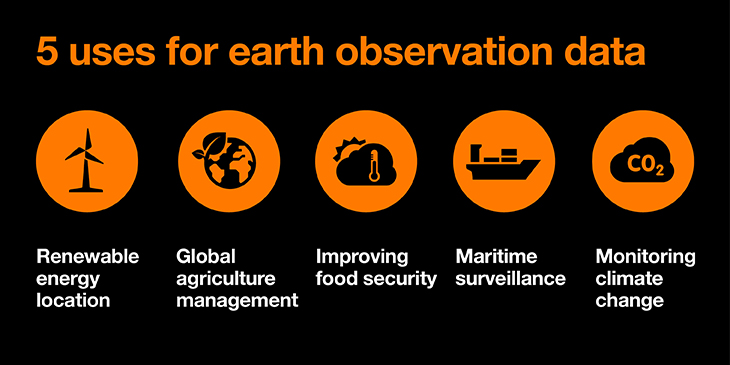Earth observation itself isn’t new. But it has been boosted by greater investment in satellites, open and free access to data and technologies, and advances in artificial intelligence (AI), machine learning (ML) and data processing. This enables the data to be used beyond the scientific community. It is opening downstream applications such as precision farming and air quality tracking for health initiatives and emergency response.
Earth observation data incorporates information about our planet’s physical, biological and chemical make-up. Earth observation data is collected via satellites and ground-based monitoring stations, aircraft and drones. Sources of earth observation data include Copernicus, the European Union’s observation program, and The National Aeronautics and Space Administration’s (NASA) Earth science data.
It plays a crucial role in decision making in several areas, including biodiversity and ecosystem sustainability, sustainable agriculture, water-resource management, public health surveillance and disaster resilience. Here are some examples of where it is already playing a role.
1. Renewable energy location
Copernicus is energizing the renewable energy sector by giving developers a point of reference when looking at possible locations for onshore and offshore wind farms. The earth observation program supports the energy sector by providing data on weather (wind, solar and hydro) and energy forecasts, including volatility and demand predictions.
To understand the potential extent of the impact of climate change on wind farm operations, an operations and maintenance model has been created based on JBA Consulting’s marine risk management application using data from the Copernicus Climate Change Service (C3S). The data was refined by Dutch research institute Deltares and is designed to represent the lifecycle of an offshore wind farm to forecast future offshore wind operations and maintenance requirements.
2. Global agriculture management
The European Commission’s Joint Research Centre (JCR) integrates satellite observations and meteorological data with baseline data on regional agricultural practices and information from crop growth model simulations. This is used to provide crop yield forecasts for EU countries and neighboring regions.
The data produced also contributes to EU external aid and development policies associated with food aid and food security policy. Assessments are measured against several indicators, including the Global Water Satisfaction Index and satellite-based crop condition indicators. Data can be used to investigate crop production in famine-prone parts of the world, for example.
3. Improving food security
A joint development initiative between NASA and the United States Agency for International Development, SERVIR works to help developing countries use data provided by earth observation satellites and geospatial technologies to manage climate risk and land use.
For example, in Southeast Asia’s Lower Mekong River Basin, SERVIR has been working with the Mekong River Commission (MRC) and other partners to combine satellite imagery, ground-based measurements and local expertise to prepare and respond effectively to drought, which has a considerable impact on its main crop, rice.
4. Maritime surveillance
Geospatial data is being used to monitor international waters as well as vessel detection and tracking. It also helps governments track what is happening in their waters. This includes contributing to a wide range of maritime policies, including oil pollution, fishery control and border control.
The European Commission’s Blue Hub integrates vessel positioning data, contextual information and satellite-based imagery to track vessels in real time. This data is used in a broad range of activities from research and development to integration with support tools for authorities and policymakers.
5. Monitoring climate change
An in-depth understanding of the planet’s ecosystem and human-created issues is essential to combat climate change and protect environments for future generations. Earth observation data will become increasingly important to many users in overcoming societal challenges and fostering a greener way of living.
The Copernicus program, for example, offers an observation-based service to monitor CO2 emissions resulting from human activities. The analysis of this data enables EU member states and other countries to track their progress in achieving the goals of the Paris Agreement, a legally binding international treaty on climate change.

Opening up a new area of Earth data exploitation with sobloo
The European Commission’s Copernicus initiative was set up to observe the planet’s environment and free access to the data. But, to facilitate sharing and provide Copernicus-related services, the European Commission and the European Space Agency (ESA) decided to set up a Data and Information Access Services (DIAS) platform, dubbed sobloo.
The sobloo platform was created by a consortium led by Airbus, Capgemini and Orange Business. The platform incorporates business tools by integrating APIs and connectors, data cross-referencing and AI capabilities to enrich raw data. In the sobloo marketplace, third parties working in the sobloo environment can publish their services.
The solution is open to encourage expansion of the information base via the cloud. Educational and research institutes looking to explore its rich data set of satellite imagery can now do so through Orange Flexible Engine. The cloud platform has been optimized for educational use and is fully aligned with the OCRE cloud framework. It is also an appealing choice from GÉANT’s cloud, the first digital single market for cloud services.
Orange Business has close partnerships within the earth observation sector. As well as delivering cloud services for the European Space Agency’s (ESA) Copernicus program to boost the use of earth observation data, we recently announced we are heading up a consortium for The National Centre for Space Studies (CNES) in France. The move is designed to accelerate the CNES’s digital transformation and further exploit the use of spatial data. Read the press release here.